Leyte’s Trade of Goods drops to $985 million in the Second Quarter of 2024

The total trade in Leyte for the second quarter of 2024 amounted to $985.64 million lower by 23.64 percent compared to $1.29 billion total trade in the same period of 2023.
Total value of imports in the province posted at $531.70 million while total exports amounted to $453.94 million for the second quarter of 2024. This translates to a Balance of Trade (BoT) of -$77.76 million.

Leyte’s Value of Imports decreases by 35.10 percent for the Second Quarter of 2024
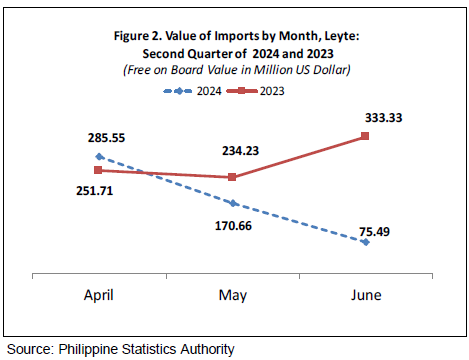
Total value of imports in Leyte decelerates from $819.27 million in the second quarter of 2023 to $531.70 million in the second quarter of 2024.
As shown in Figure 2, the value of imports in May to June of 2024 were generally lower compared with the same period of 2023. Value of imports in April 2024 was higher by 13.44 percent from $251.71 million of April 2023.
Moreover, the value of imports for May and June of 2024 falls by 27.14 percent and 77.35 percent,
respectively. The value of imports decelerated from $234.23 million (May 2023) and $333.33 million (June 2023) to $170.66 million (May 2024) and $75.49 million (June 2024).
Total Exports in Leyte drops to $453.94 million in the Second Quarter of 2024
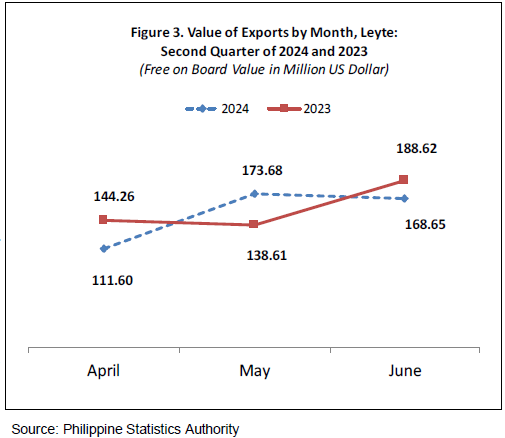
Leyte’s exports decreases to $453.94 million in the second quarter of 2024 lower by 3.72 percent from $471.50 million in the second quarter of 2023.
The same scenario was observed in the exports monthly performance of the province. Monthly exports of April and June 2024 except for May, were lower compared in 2023. The value of exports in May 2024 was higher from $138.61 million to $173.68 million showing a 25.30 percent increase in the same period of 2023.
However, value of exports for April and June of 2024 posted decreases of 22.64 percent and 10.59 percent, respectively.
About 73 percent of Leyte’s Total Imports passes through LIDE Port
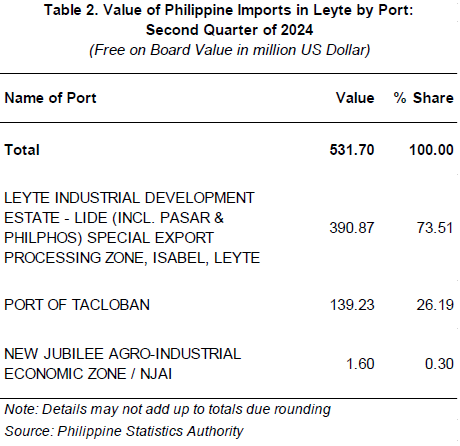
Seventy three percent of imports in Leyte came from the port of Leyte Industrial Development Estate (LIDE). This is a Special Export Processing Zone in Isabel, Leyte which include PASAR and PHILPHOS. This port posted an aggregate receipts of$390.87 million for the second quarter of 2024.
The Port of Tacloban came next comprising 26.19 percent amounting to $139.23 million.
Meanwhile, New Jubilee Agroindusrial Economic Zone/NJAI comprised 0.30 percent of Leyte’s total imports valuing at $1.60 million.
LIDE Exports at $453.93 million in the Second Quarter of 2024
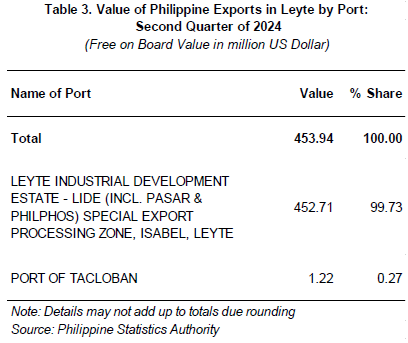
Only two ports in Leyte were reported to have export transactions in the second quarter of 2024, namely, Leyte Industrial Development Estate– LIDE and Port of Tacloban.
The port of LIDE posted an aggregate receipts from merchandise exports of $452.71 million which is 99.73 percent of the total export of Leyte for the quarter in review.
The remaining 0.27 percent came from the Port of Tacloban posting an aggregate receipts of $1.22 million in the second quarter of 2024.
Copper ores and concentrates posted as Top Major Import in the Second Quarter of 2024

As seen in Table 4, the commodity group of Copper ores and concentrates: concentrates was the major import during the reference quarter comprising 42.61 percent with a total value of $226.55 million.
The second major import of the province was the commodity group of - - - Of silver, including metal clad with silver but excluding sweepings containing other precious metals. The FOB value of this commodity group amounted to $104.14 million which shared 19.59 percent of the total imports of the province.
The remaining top five commodity groups include Petroleum oils and oils obtained from bituminous minerals (other than crude) and preparations not elsewhere specified or included, containing by weight 70 % or more of petroleum oils or of oils obtained from bituminous minerals, these oils being the basic constituents of the preparations, other than those containing biodiesel and other than waste oils : | - - Other : | - - - Diesel fuel; fuel oils : | - - - - Fuel oils | Gas oils ($92.12 million); Rice. | - Semi-milled or wholly milled rice, whether or not polished or glazed : | - - Glutinous rice : | - - - In-Quota ($31.17 million); and Precious metal ores and concentrates. | - Other | Concentrates of gold (excluding gold from copper ores and copper concentrates) ($25.30 million). These three (3) commodity groups accounted 27.95 percent of the total imports of the province.
Refined copper is the Top Export commodity valued at $315.42 million

Refined copper and copper alloys, unwrought. | - Refined copper :| - - Cathodes and sections of
cathodes was the major export during the reference quarter valuing at $315.42 million. This accounted for 69.49 percent of the province’s total export revenue in the second quarter of 2024.
The remaining top five exports include Copper
ores and concentrates. | Copper ores and concentrates. | Concentrates ($132.61 million); Mineral or chemical fertilisers containing the three fertilising elements nitrogen, phosphorus and potassium ($3.94 million); Pulps of fibres derived from recovered (waste and scrap) paper or paperboard or of other fibrous cellulosic material. | - Other : | - - Obtained by a combination of mechanical and chemical processes : | - - - Abaca pulp ($1.22 million) and Sulphuric acid containing by weight more than 80 % of H2SO4 ($0.58 million).
These four (4) commodity groups accounted 30.48 percent of the total exports of Leyte.
Indonesia is Leyte’s Top Import Trading Partner in the Second Quarter of 2024
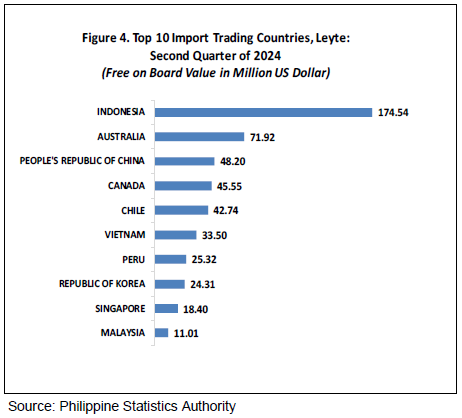
About 32.83 percent of the imported goods of Leyte in the second quarter of 2024 came from Indonesia with total value of $174.54 million. Australia ranked second posting a value of $71.92 million, followed by People’s Republic of China with a total value of $48.20 million.
The other countries which completed the top 10 import trading partners of Leyte include Canada ($45.55 million), Chile ($42.74 million), Vietnam ($33.50 million), Peru ($25.32 million), Republic of Korea ($24.31 million), Singapore ($18.40 million) and Malaysia ($11.01 million).
Exports Receipts to People’s Republic of China valued at $225.95 million
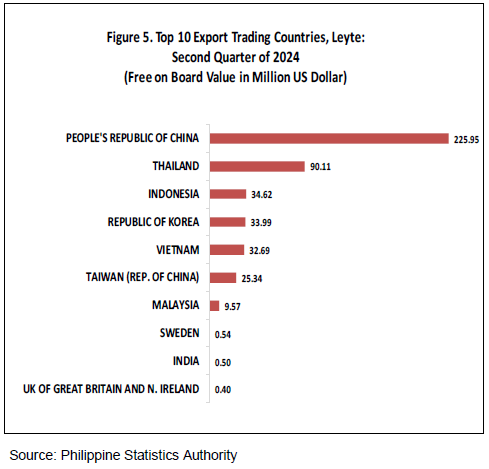
People’s Republic of China was the top export market destination of Leyte in the second quarter of 2024 with an aggregate receipts of $225.95 million or 49.78 percent of the total exports of Leyte.
Thailand was the second export trading parner of the province with total receipts of $90.11 million. Indonesia ranked third valuing at $34.62 million, followed by Republic of Korea at $33.99 million. Vietnam ranked fifth with $32.69 million.
The rest of the countries namely Taiwan (Rep. of China), Malaysia, Sweden, India and UK of Great Britain and N. Ireland recorded around $36 million exports transactions.
EXPLANATORY NOTES
Foreign trade relates to the commerce between the Philippines and other countries by sea or air, whether for private or government use or for commercial purposes, as gifts, or samples. Foreign trade statistics are used for economic planning and for formulation of trade policies and measures. These statistics are also useful for computation of balance of payments, national accounts, and net terms of trade; trade promotions; monitoring of importation of taxable and duty-exempt items including imports under the Import Liberalization Program; and for inputs in bilateral and multilateral trade negotiations.
Foreign trade statistics are compiled by the Philippine Statistics Authority (PSA) from copies of legally required documents submitted by importers and exporters to the Bureau of Customs. Exports and imports cleared through Philippine Exports Zone Authority (PEZA) forms are also included in the compiled data. PSA collects copies of the following accomplished forms:
Export Declaration (ED—DTI form)
Import Entry and Internal Revenue Declaration (BOC IEIRD Form 236)
Informal Import Declaration and Entry (BOC Form 177)
Single Administrative Documents (SAD)
The Philippines adopts the “general” trade system of recording foreign trade statistics and the customs frontier (not the national boundary) is used as the statistical frontier. Under this system, all goods entering any seaport or airport of the Philippines that are properly cleared by Customs or remaining under customs control are considered imports. These goods are imports regardless if they are for direct consumption, for merchandising, for warehousing, or for further processing. On the other hand, all goods leaving the country that are properly cleared through Customs are considered exports. A distinction, however, is made between exports of goods grown, mined, or manufactured in the Philippines (domestic exports) and exports of imported goods that do not undergo physical and/or chemical transformation in the Philippines (re-exports).
Since 1982, goods are considered imported on the date the carrying vessel or aircraft arrives at the port of unloading. In reverse, goods are considered exported on the date the carrying vessel or aircraft departs from the loading port.
SGD. SHERYL ANN A. JAMISOLA
Chief Statistical Specialist

